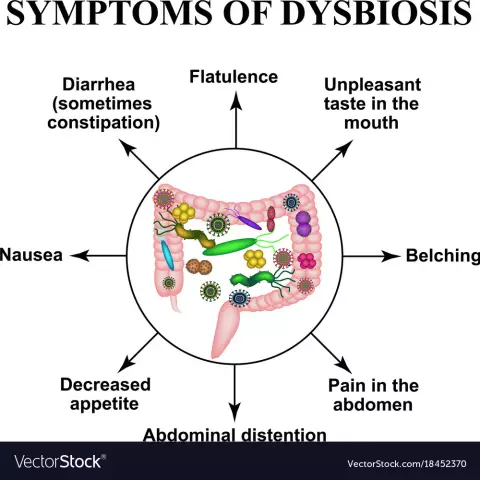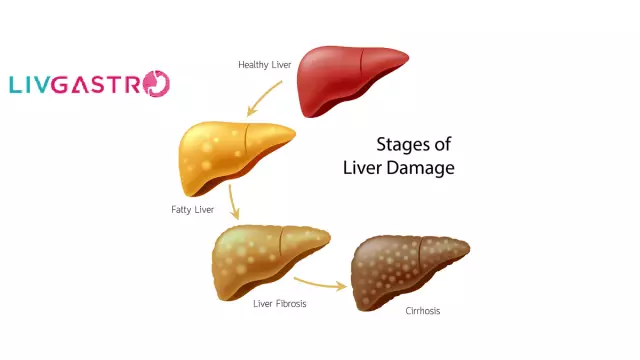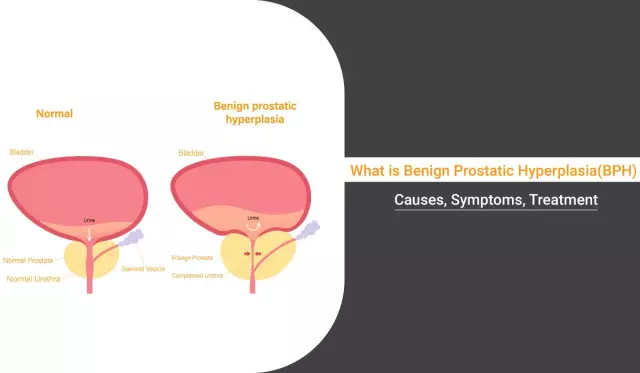Diseases
Last modified: 2025-11-02 20:11
Dysbacteriosis is a violation of the normal composition of the beneficial microflora. Treatment is usually difficult and lengthy. First of all, the cause of dysbiosis is eliminated, and those diseases that led to it are treated (if it is in them)
Last modified: 2025-11-02 20:11
Dipylidiosis is a rare anthropozoonotic disease caused by dipylidium, a cestode class helminth. In connection with the similarity of the segments of the parasite with the seeds of a cucumber, the helminth was named "cucumber tapeworm" ("borage"). The disease is characterized by dysfunction of the gastrointestinal tract and the development of toxic-allergic reactions
Last modified: 2025-11-02 20:11
Dyshidrosis - a pathology of the skin, characterized by blockage of the ducts of the sweat glands
Last modified: 2025-11-02 20:11
Dirofilariasis is a transmissible zoonotic helminthiasis, provoked by round worms (nematodes) Dirofilaria (dirofilariae), which are characterized by parasitism in the subcutaneous fat, less often in the internal organs of a person
Last modified: 2025-11-02 20:11
Atrial dilatation is an expansion of the cavity of the left and (or) right atria while maintaining the normal thickness of the walls that form them. This condition is not an independent disease and is considered as one of the symptoms characteristic of a number of congenital or acquired pathologies of the cardiovascular or respiratory system
Last modified: 2025-11-02 20:11
Dysbacteriosis in children is a qualitative and quantitative violation of the composition of the microflora, in which opportunistic microorganisms predominate in the intestine
Last modified: 2025-11-02 20:11
Dyshidrotic eczema is a chronic skin disease of the hands or feet. It is manifested by periodic vesicular rashes and severe itching
Last modified: 2025-11-02 20:11
Dysbacteriosis of the vagina is a violation of the normal microflora of the vagina, in which opportunistic and / or pathogenic microorganisms prevail in its structure
Last modified: 2025-11-02 20:11
Dysmenorrhea is a pathological process in women, which is characterized by severe pain during menstruation
Last modified: 2025-11-02 20:11
Dyskinesia is a violation of the contractile function of smooth muscles of internal organs, which can have different origins
Last modified: 2025-11-02 20:11
Dyslipidemia is a violation of the ratio of cholesterol fractions in the blood, which does not have specific clinical manifestations, but provokes the development of pathologies
Last modified: 2025-11-02 20:11
Intestinal dyskinesia is a common pathological condition in which there is a violation of the motor function of the intestine
Last modified: 2025-11-02 20:11
Dyspepsia is a combined functional disorder of the digestive system. Treatment of dyspepsia of alimentary origin consists in the appointment of a hunger pause, lasting from a day to one and a half
Last modified: 2025-11-02 20:11
Dislalia is one of the most common speech defects, which is characterized by impaired sound pronunciation, with preserved hearing and innervation of the articulatory apparatus
Last modified: 2025-11-02 20:11
Dysmorphophobia (from ancient Greek δυσ - a prefix with a negative value, μορφή - "appearance", "appearance", φόβος - "fear") is a mental pathology, which is based on a panic fear of physical imperfection in the absence of objective reasons or existing substantially overestimated minor defects
Last modified: 2025-11-02 20:11
Dyskinesia (dysfunction) of the biliary tract is a functional disease of the biliary tract, which is based on impaired motility of the gallbladder and its ducts, which causes a violation of the outflow of bile into the duodenum. Dyskinesia of the biliary tract is approximately 70% in the structure of pathologies of the biliary system. Women are more susceptible to pathology
Last modified: 2025-11-02 20:11
Gallbladder dyskinesia is a disorder of its motility, as a result of which the flow of bile into the duodenum is disrupted
Last modified: 2025-11-02 20:11
Dyspareunia is a sexual disorder characterized by painful sensations during or after intercourse. It occurs in 15-60% of women
Last modified: 2025-11-02 20:11
Dysplasia of the cervix is a condition of the mucous membrane of the cervix and vagina, in which the appearance of cells of atypical structure is observed. The modern level of medicine allows you to completely get rid of the disease
Last modified: 2025-11-02 20:11
Dysthymia is a mental illness that manifests itself as pronounced pessimism
Last modified: 2025-11-02 20:11
Dystonia is a neurological disorder characterized by a complex symptom complex of various clinical manifestations, affecting various organs and systems
Last modified: 2025-11-02 20:11
Dysplasia of the hip joint - an inferiority of the hip bone joint, caused by a violation of the structure of the joint structures
Last modified: 2025-11-02 20:11
Dystopia is a pathological condition characterized by the movement of individual organs, tissue or cells to an atypical place for them
Last modified: 2025-11-02 20:11
Dissociative disorders are a group of mental disorders characterized by impaired memory, consciousness, and a sense of personal identity. Normally, all these mental functions are integrated into consciousness. Upon dissociation, some of them separate from the community and become independent
Last modified: 2025-11-02 20:11
Connective tissue dysplasia is understood as such a genetically determined abnormality of tissue development, in which the ratio of collagen fractions is changed (or their deficiency is noted), defects of both fibrous structures and their own substance are formed. The result is multiple dysfunctions at all levels of the organization, from cellular to organismal
Last modified: 2025-11-02 20:11
Dysplasia of the hip joint (from ancient Greek δυσ - "violation" and πλάθω - "form") - a pathology caused by a violation of the formation of elements of the joint itself and its auxiliary apparatus in the prenatal period
Last modified: 2025-11-02 20:11
Dystrophy is a disease caused by energy and protein deficiency. According to statistics, it is diagnosed in 2% of children living in the CIS countries and Europe
Last modified: 2025-11-02 20:11
Dissociative identity disorder (split personality, multiple personality disorder, multiple personality disorder) is a rare mental disorder, one of the dissociative disorders, manifested by the presence of two or more personalities in the patient, alternating with each other. These personalities are often called identities, ego states, alter personalities
Last modified: 2025-11-02 20:11
Retinal dystrophy is the main cause of poor vision in the elderly. In the treatment of retinal dystrophy - photodynamic therapy, laser photocoagulation and Anti-VEGF drugs are used
Last modified: 2025-11-02 20:11
Dysfunctional uterine bleeding - a disease that manifests itself as bleeding in a woman's uterus
Last modified: 2025-11-02 20:11
Dysphagia - difficulty swallowing, is a symptom of diseases of the upper gastrointestinal tract and nervous system. Treatment of dysphagia is reduced to the use of local remedies to relieve its symptoms
Last modified: 2025-11-02 20:11
Corneal dystrophy (keratopathy) is a general definition of a group of diseases characterized by changes in the structure of the cornea, which is accompanied by a progressive decrease in visual acuity. The disease often manifests itself between 10 and 40 years
Last modified: 2025-11-02 20:11
Diphyllobothriasis is an infection of the body with intestinal helminths Diphyllobotrium, accompanied by lesions of the gastrointestinal tract, megaloblastic anemia. If anemia is severe, a course of vitamins and iron preparations is prescribed before the elimination of the helminth begins
Last modified: 2025-11-02 20:11
Ovarian dysfunction can lead to menstrual irregularities, uterine bleeding, the disappearance of ovulation, the manifestation of premenstrual syndrome
Last modified: 2025-11-02 20:11
Dysfunction of the sphincter of Oddi is a benign disease of a non-calculous (not associated with the presence of stones in the gallbladder and ducts) nature, manifested by a violation of the movement of bile along the bile duct at the point of their confluence with the pancreatic duct
Last modified: 2025-11-02 20:11
Diffuse thyroid lesions are diffuse or focal lesions of the thyroid gland
Last modified: 2025-11-02 20:11
Benign prostatic hyperplasia, or adenoma, are lumps in the prostate that compress the urethra
Last modified: 2025-11-02 20:11
Pain syndromes in the lumbar spine occur in 17% of the adult population. As a rule, they are all associated with degenerative changes in the spine, which cause pain
Last modified: 2025-11-02 20:11
Dyscirculatory encephalopathy is a multifocal or diffuse vascular lesion of the brain with slow progression
Last modified: 2025-11-02 20:11
Dolichocolon is a disease characterized by lengthening of one or more sections of the large intestine without changing the diameter of its cavity and without thickening the muscle layer. The consequence of this abnormal development is a violation of the evacuation function of the intestine, while the motor function does not change. The disease occurs in both adults and children








































